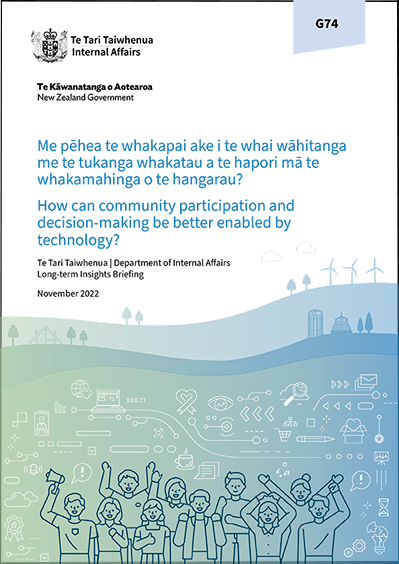Long-term Insights Briefing
Welcome to our Long-term Insights Briefing, which considers: How can community participation and decision-making be better enabled by technology? Me pēhea te whakapai ake i te whai wāhitanga me te tukanga whakatau a te hapori mā te whakamahinga o te hangarau?
Long-term Insights Briefing [PDF, 2MB]
The briefing looks forward at least a decade. It is our chance to examine key issues, trends and different scenarios, and investigate options for navigating the years ahead.
Community participation, technology and decision-making are at the heart of much of Te Tari Taiwhenua’s mandate and mahi, playing a key role in how we serve and connect people, communities and government to build a safe, prosperous, respected nation.
Technology is changing how we interact and connect, how we make purchases and spend our spare time, and how we work. In this Briefing, we have challenged ourselves to consider what trends will have an impact on community participation and decision-making over the next 10 years and what might be possible through technology.
It’s also an opportunity to look at how we ensure the Treaty of Waitangi | Te Tiriti o Waitangi is honoured and to improve how we partner with and support Māori to achieve their own aspirations.
Strong communities have active, engaged people at the centre. Active, engaged people participate in important decisions, and they share their opinions and ideas for the future. The more community voices are heard in decision-making, the better any solutions are likely to be.
And the more that people believe their concerns have been heard and their histories acknowledged — whether by government or even within their own communities — the greater their trust in the solutions, and the greater their willingness to participate in the future. It’s a process that reinforces and renews itself again and again.
The Briefing considers proven methods and initiatives at a national and international level that we want to expand on. It also reflects community perspectives on an ideal future state to ensure we’re envisaging a way forward that works for all Aotearoa.
We’ve discussed examples of what could be done. In some cases, there’s more work to do.
We think the opportunities are exciting, and the ideas presented here are only the start of the conversation.
What we found
Communities we spoke to said that they want a future where they would know their views made an impact.
We have identified a handful of options that governments could consider:
- Treating access to digital technology as a human right and meeting the digital inclusion goals of Aotearoa
- Partnering for smart towns
- Investigating how technology could connect volunteers, charities, and funders
- Exploring new ways to bring people together to reach consensus through technology
- Establishing trusted spaces, online and offline.
What you need to know about this briefing
The briefing is a think piece on the future, not government policy.
The requirement to publish a briefing is a statutory duty on departmental chief executives, independent of ministers. It differs from the advice that the public service provides ministers, or the accountability and planning documents prepared for Parliament.
Want to know more?
You can learn more about Long-term Insights Briefings through the Policy Project (DPMC website).
